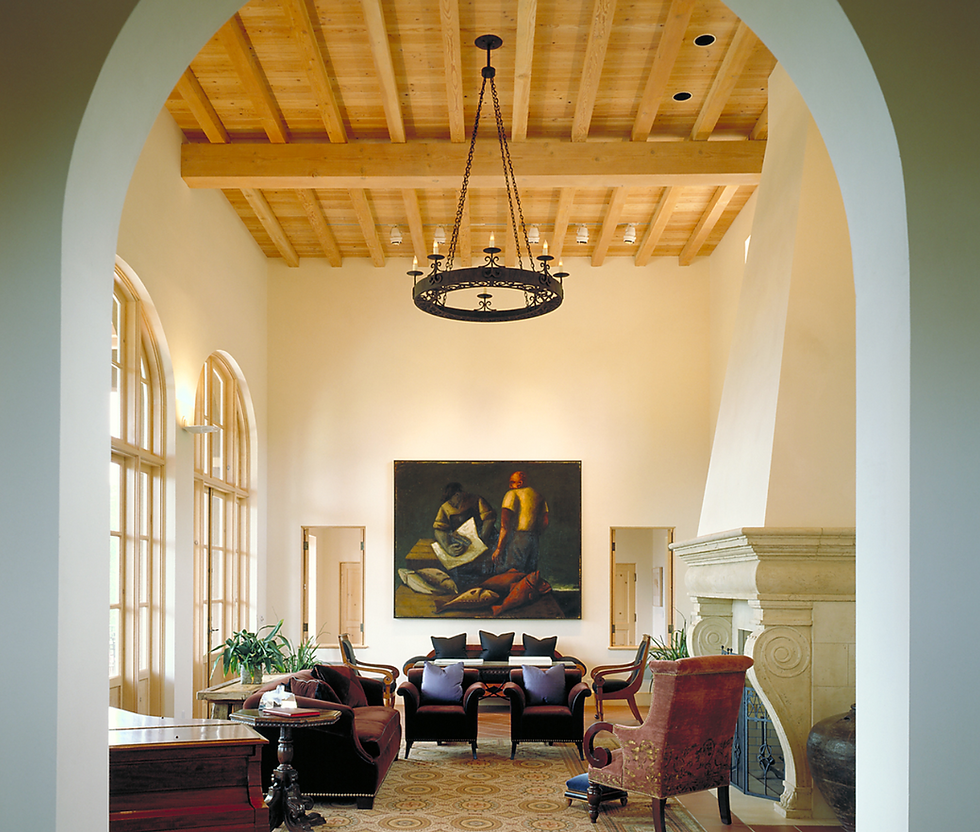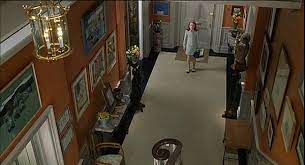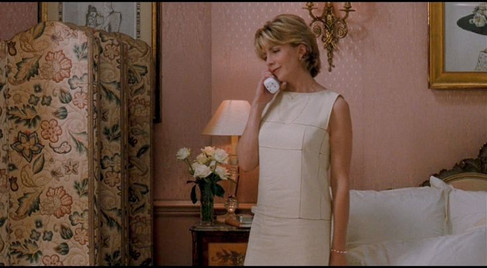Formative Spaces: Movie Magic
- Rebekah Hall
- Jan 26, 2024
- 8 min read
On the movies from my childhood that inspired my love of interiors
By Rebekah Hall Scott

When I think about my earliest memories of inspiring interiors, my mind drifts easily to the movies of my childhood and their beautiful spaces designed to enchant. I close my eyes and picture their rich colors, their specific and intentional details, their right-sized excess of scale and layers, perfectly conceived and crafted to capture the imagination of a child.
If you've been a consistent Butter Yellow Home reader (hello, and thank you,) you'll find that many stalwarts of my design dreams — canopy beds, window seats, etc. — have their origin in these movies. Below, in the order that they were released, I round up the most interiors-formative movies of my youth.

A Little Princess (1995)
If my Canopy Fantasy can be said to have begun somewhere, it was surely after watching this lush, stunning movie for the first time. The story, based on the 1905 novel, follows young Sara Crewe after her father, a wealthy British Army officer, is called to serve in World War I. They leave their home in India and he enrolls her at a girls' boarding school in New York City. (You will see boarding school emerge as a theme among my selections here.) Lots of other things happen too, but I'm here to talk about the incredible visuals and magical interiors featured in this film, directed by Alfonso Cuarón (same director of the undeniable best of the Harry Potter films, number 3, Prisoner of Azkaban.)
Though the movie takes place mostly in NYC, it cuts several times to both real and storybook depictions of India, resplendent in rich colors and golden light. I remember loving these colors and how yummy they looked, and the rich textures of the bedclothes, draperies, and the dresses worn by the girls. In one scene, pictured at the very top of this story, Sara and her friend Becky, who have both been forced to work as servants in the school, awake to find their crumbling attic room has been magically transformed into a sumptuous canopied gem, covered in sun-drenched orange and yellow textiles that look good enough to eat, the walls outfitted in decadent sheets of taffeta. I recently watched this movie again for the first time since childhood, and this scene took my breath away just as it did every time I watched as a kid. As with the rest of these movies, it makes me look forward to sharing these with my children someday.

Madeline (1998)
"In an old house in Paris that was covered in vines, lived 12 little girls in two straight lines." This classic is up there with the most-quoted movies in the Hall house growing up because of one girl's remark upon seeing Madeline's appendectomy scar — "It's gi-NORmous!" Just as this line has remained a fixture in my family, the interiors of this movie have stayed with me. It's just so deliciously FRENCH and sweet. I mean, the beautiful façade of the home with that iconic climbing ivy! The absolutely perfect bedroom pictured above, where each girl has their own overhead shelf and lamp, the dormer windows and transom window above the door, the orderly symmetry of their beds lined up in two rows and the satisfying long runner dividing them. A place for everything and everything in its place, but brightened by the girls' individual personalities and possessions. That perfect childhood balance of soothing order and routine with plenty of room for expression.

Above, another example of how beautifully this movie does justice to its original source material as a children's book — like, of COURSE the bathroom in the girls' boarding school would have twelve individual sinks lined up in two rows to face each other. The scale of it all feels like a nod to dollhouses and miniatures, little sinks and soap dispensers for little hands. Also, the subtle textured wallpaper in this room? The yellow and blue patterned drapes? A dream! Around the corner from this shot, there's a long skirted vanity in the same material as the drapes. Swoon!
When I recently re-watched this movie, I also noticed the gorgeous painted wood floors pictured above, in a faded creamy yellow and green harlequin pattern with a stenciled border. I think a painted wood floor, especially in a high-traffic room like a kitchen or mudroom, wears so beautifully over time and makes a home feel special. I included the picture on the right because of how important the depiction of all the girls in their nice party dresses was to me when I was a little girl. Their matching white Mary Janes, white socks and white gloves... the variations on hairbows and sweet collars... all looking so crisp and sugary. It made me want an old-fashioned party dress with a gathered skirt.

The Parent Trap (1998)
Listen. I could, as many others have, write an entire story about the interiors of Nancy Meyers movies. The homes in her films are chic, crisp and comfortable, filled with fresh cut flowers and honeyed natural light. They feel like real places that real people — albeit real rich people — could live in. These are not the Wayfair/Amazon nightmares we've become accustomed to seeing in the background of today's straight-to-streaming romcoms. In Nancy Meyers's movies, the homes reflect her characters' styles and attitudes and passions, and the homes of The Parent Trap are great examples of this.

Twin girls, separated at birth by their parents, both played by Lindsay Lohan in a true feat of Movie Magic, inexplicably meet each other at summer camp and discover they're long lost sisters. In a plot to get their parents back together, the girls decide to switch places and meet the parent they've never known. One jets off to her mother's Hyde Park townhouse in London, and the other to her father's Napa Valley home on a winery. And we, as the audience, benefit from these visits into two distinct but equally cozy homes. The Spanish-style abode of their father, played handsomely by famously handsome Dennis Quaid, is a California dream. Ivy climbs the walls, earthy paint colors ground the interiors despite the lofty ceilings, and Hallie's bedroom — with buttery knotty-pine built-ins as pictured above — is the colorful, layered, just-messy-enough tween bedroom of my dreams.
In London, we meet the twins' stunning mother Elizabeth James, played beautifully by famously beautiful Natasha Richardson, in her gorgeous townhouse. Her character is a wedding dress designer, so naturally the home is classic and leans more traditional, but it's also romantic and fresh. I read that the home's foyer was painted in this dreamsicle shade to match Lindsay Lohan's hair! Imagine that — a room being painted just to compliment your hair. When Annie walks into her mother's home for the first time, she's stunned by this grand curving staircase, and so are we as viewers. Lined with interesting art, the room strikes exactly the right note.
For my part, I wanted to dive into the plush white comforter and fluffy pillows on her mother's bed and never leave. Everything about her lovely, feminine bedroom is perfect: the subtle sheen of her embossed rosy pink wallpaper, what looks like a spectacular embroidered dressing screen, design sketches hung in gilded gold frames, and, yet again, a KILLER window seat. Imagine taking tea in the comfort of this window seat, as Elizabeth is doing above. It's so divine, and such a wonderful manifestation of how an elegant, chic wedding dress designer could be imagined to live. Inject this vibe straight into my veins.

The Princess Diaries (2001)
I remember when my little sister turned 7 or 8, and she got two incredibly sick gifts from my parents: the first was an inflatable Hello Kitty chair, and sitting in its seat was The Princess Diaries on DVD. I was jealous of the chair, and thrilled about having our own copy of this movie. The breakout role of Anne Hathaway, directed by Garry Marshall, who's responsible for many favorites of this era: Runaway Bride, Pretty Woman, Overboard, etc. I remember watching the DVD commentary (were you a bonus features family too??) and there was a bit about how Garry Marshall's granddaughter told him the lead of this movie had to have a "princess smile," and when Anne auditioned, her smile sealed the deal.

If the previous movies provided girl-bedroom inspiration, Princess Diaries was a large part of my transition to teen-bedroom inspiration. Anne's character Mia and her artist mother live in a refurbished San Francisco firehouse (I mean........ come on) and Mia has her own lair within it, complete with a spiral staircase leading to a tower painted like a blue sky with a sliding trapdoor entry. Her room looks lived-in and realistic, hung with posters and pictures and, to tween-age me, scattered with the fascinating ephemera of adolescence: a few stuffed animals lingering from childhood, trinkets and keepsakes, tie-dye sheets, old copies of National Geographic magazine. You get a sense of her personality, interests and values. I think this sense of layered self-expression really informed the way I decorated my space as a teenager and the way I value sentimentality and personal history in decorating today.
I love what we see of the interior of the firehouse: these doors and their transoms painted in a purple wash, the art supplies and works-in-progress living among them, the mix of Craftsman and Victorian furniture with what appear to be thrift-store finds and DIY projects. It's richly textured and full of imagination and creativity — as the home of an artist and her teenage daughter should be.
On memory and media, briefly
These fictional spaces — which are none the less "real" in the physical-ness of their existence, having been touched by human hands — made me more interested in my own spaces and in those around me. I think having these images on replay made me more observant of the details in my friends' homes, of the homes of my neighbors in my cul-de-sac, of the architectural details of the church I grew up in.
And at the root of what I call back to myself when I close my eyes and enter this memory soup, this boundary-less blend of fiction and real-life, is how these spaces made me feel. The swirling golden dust captured by beams of light in A Little Princess remind me of those same mystic beams of light and dust I saw looking up to the cavernous ceiling of my church's sanctuary, tilting my head back against the pew, too young to pay attention to the sermon. When I conjure these memories, they make me feel warm and safe, and there's almost a tangible sense to them — like I can run my finger around the edges of the wormhole that takes me back to the original vantage point through which I first noticed these things.
Reflecting on these movies, and on my childhood, brings the realization that there are formative expressions and ideas of gender here, too, and not in a way that imposes rigidity but rather one that invites delight. Nightgowns, hairbows, gathered curtains with pattern and trim; here was femininity that felt delicious and decadent and innocent — beauty for beauty's sake, easy to slip into. When I think of the interiors of these movies and how they felt to my child self, they ring a bell in the Raised As A Girl In The South part of my mind (arguably inextricable from any other part of my mind), the part that has long loved a skirted side table or the way summer sunlight looks streaming through a linen Roman shade. From this same place come other echoes: perfume bottles glitter on a mirrored tray atop the vanity in a friend's mother's bathroom; the faint chemical smell of fresh paint as it dries in my parents' bright bedroom, windows thrown open, while my mom's voice sings along to the Dixie Chicks playing on a boom box, happy in the Doing of making a home. The soothing balm of cool tile floor on dirty bare feet, warm from the earth.
My brain tangles these images and memories together in a kaleidoscopic sensory haze. It doesn't really matter which came from the world around me and which came from the worlds inside those movies because they are essentially one and the same: this media was part of the world around me, too. They all converge in the great pool of my memory, and they all work to wash me ashore into each new day.
I'll end this on a special quote from the late poet and Nobel prize winner, Louise Elisabeth Glück, that I've been unable to shake from my mind recently:
"We look at the world once, in childhood.
The rest is memory."























Comments